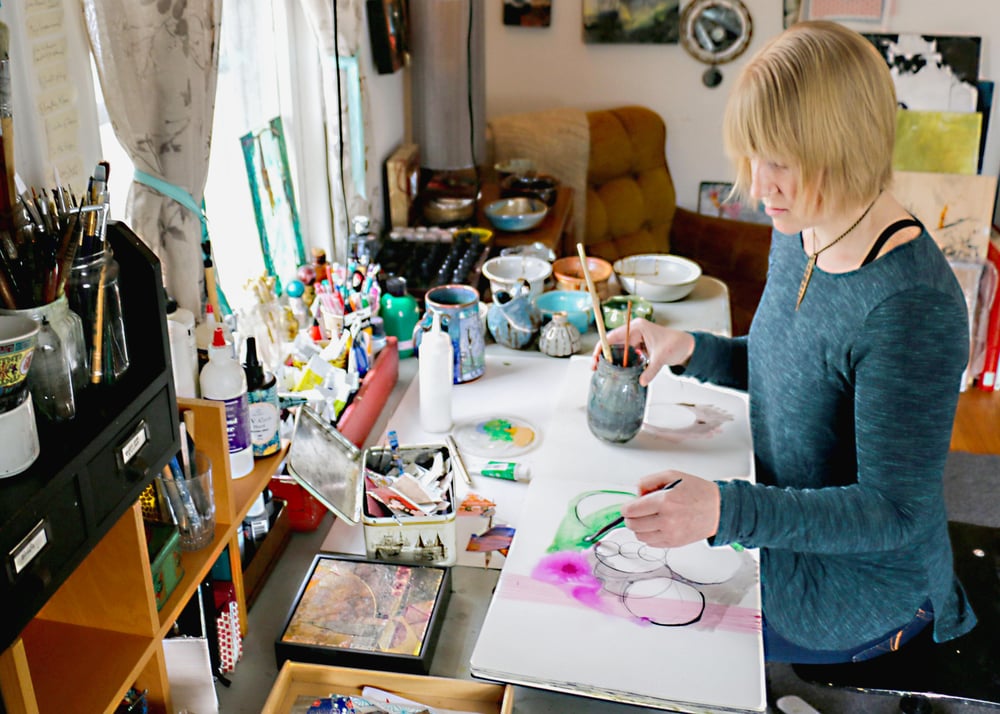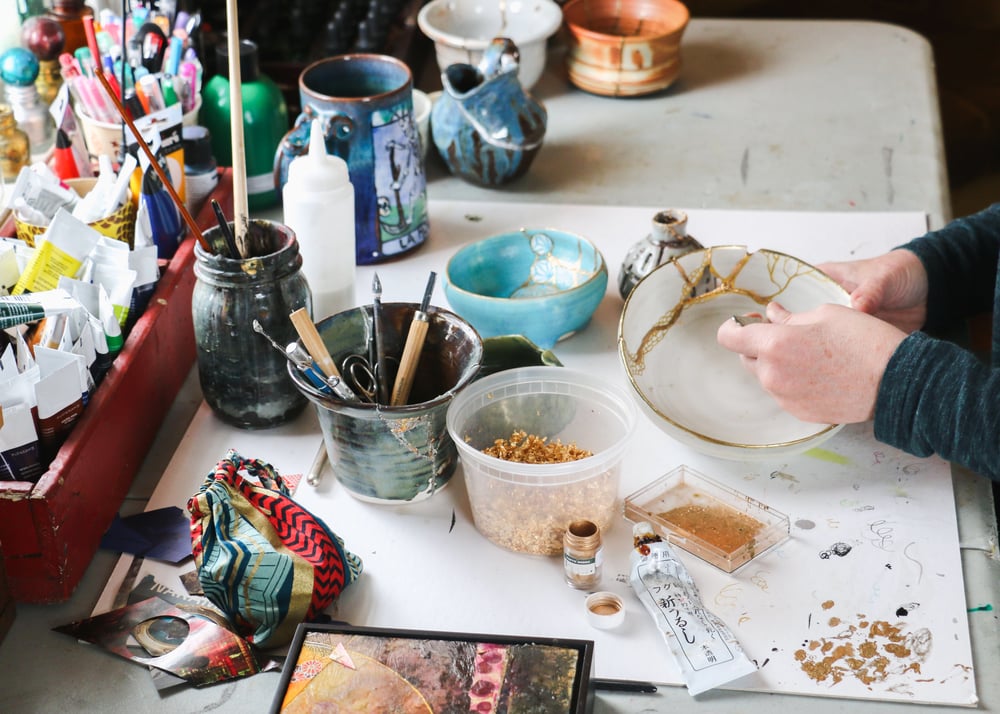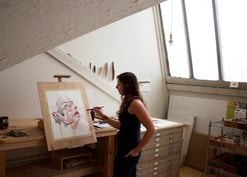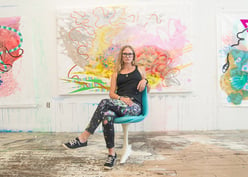TurningArtist Jen McCleary works in digital collage, mixed-media collage, jewelry, and wheel-thrown ceramics embellished with decoupage and kintsugi (the traditional Japanese technique of repairing broken pottery with lacquer and gold).
While seldom working in just one medium or on one idea, certain themes have certainly emerged in her work like exploring dualities such as light/dark, life/death, or natural/manmade. She loves experimenting with color and texture in her works and always leaves the final product open-ended so her viewers can discover their own relationship with her work.
We interviewed Jen to learn more about her artistic process and how she remains creative and productive during these tumultuous and often stressful times. Can you tell us about your journey to becoming a professional artist?
Can you tell us about your journey to becoming a professional artist?
I always loved making art as a child, and I knew by high school that I wanted to go to art school. I double-majored in painting and printmaking for my BFA but really struggled to find my own artistic path. I had a positive turning point when I studied in Rome for a semester and took a “sketchbook” class in which the professor really encouraged not just drawing, but using various media, adding collage, and exploring the book as an art form in itself.
The years after graduating from art school were quite difficult for me. I had absolutely no idea how to make a living as a fine artist and certainly lacked the confidence to do so. I worked in academic publishing doing editing and project management for the first few years after art school. This caused a bit of an identity crisis for me about not being a “real artist.” I always kept working on my art every moment I could, and finally, six years later I finally felt confident enough to start showing my work.
I’ve always felt that for me, it was best to have a steady income to support my fine art rather than potentially turning the thing I loved the most into a source of stress. I went back to school for a continuing education certificate in print design and began working full-time as a graphic designer at a local university. This enabled me to complete a custom interdisciplinary MLA exploring art, culture, and history. Through all this, I’ve continued to show and sell my art online, at local shops, art fairs, and galleries.
In 2013 my full-time design job ended and I took the opportunity to go freelance. My experience in the publishing industry has enabled me to specialize in book layout and cover design, which I love. This current working arrangement gives me an ideal balance between a steady income and the flexibility to focus more on my personal art than I could while working a regular 9-5 job.
Can you tell us about your process?
My process has a lot of similarities no matter the media. Everything is fair game to be re-used and re-interpreted. I will paint over digital collage prints and use scans of mixed-media work in my digital collages and graphic design work.
I prefer to work in a very intuitive way, adding a little bit here and there to multiple pieces simultaneously. I like choosing elements at random from my boxes of paper ephemera or folders of digital photos. Sometimes different collage elements almost seem to fit into place like a puzzle piece, and other times it’s more of a struggle. I frequently record my creation process using time-lapse videos and photos of pieces at various stages. The evolution of a piece over time is actually more interesting to me than the end result, and I love being able to share this with people.
.jpg?width=1000&name=Dp5T_009_HS2_9400_HaSte%20(1).jpg)
When you are looking for inspiration, what resources do you turn to?
I think everything can be a source of inspiration! Sometimes it’s going for a long hike in the woods and seeing an interesting tree. Sometimes it’s going to a concert and the stage lights cast interesting shadows. I love traveling to different cities and wandering, and of course, going to museums and seeing what catches my eye. I’m an avid reader and sometimes an intriguing phrase will turn up that becomes the title of a painting. Sometimes just looking through the collage materials that I’ve collected will spark an idea. Right now I’m staying at home because of the COVID-19 situation, so I’m looking at a lot more art online and also revisiting my collection of art books for inspiration. I particularly love the work of Joseph Cornell and HEIRONYMOUS BOSCH.
Walk us through a typical day in your studio. What is your routine?
I’ve been freelancing for almost seven years now and I’m still perpetually tinkering with how to best optimize my time! It’s difficult because my design workload can vary tremendously. Sometimes I have days where I spend twelve or more hours almost nonstop on the computer to meet a project deadline, and at the other end, I have days where I am utterly non-productive (but I do think that is actually necessary to the creative process!). In the middle of those two extremes, I do try to devote most of the morning to working on art projects. For most of my life, I considered myself a night owl, but I’ve found that doing the things that I care about most first thing in the morning is the best way to ensure that they actually get done. 
For emerging artists, finding the right rhythm to be productive in the studio can be a challenge, what advice do you have for staying productive and focused?
I think it’s all about removing hidden friction and distractions that keep you from having a focused and pleasant working experience. Take stock of your workspace- is it pleasant to be in? Can you find the materials you need easily, or could they be organized better? Absolutely turn off all the things that beep to get your attention! Make sure you have something to drink, and something to listen to if that’s your thing. Ideally, I get into a “flow” state where I completely lose track of time and the creative process is a pure joy.
What is your advice for combating creative block?
The first thing I advise is to try to do a little bit of something every day. Even if you have only two minutes to make art, that is better than nothing. Even if you’re not feeling motivated, you can do anything for two minutes, and doing something small sets up a feeling of momentum and accomplishment. Setting a tiny goal also takes the pressure off the feeling that you have to make something “good.” I like to remember that many drops of water make up an ocean.
The second method I’ve been experimenting with lately is using randomness to spur creativity and make the process more fun. My favorite method for this is to use dice- for instance, 1 is watercolor, 2 is acrylic, 3 is ink, 4 is collage paper, and so on. And then once I’ve chosen a material in this way, I’ll roll again to pick a color or a piece of paper from a box of collage materials, etc. I like using gaming polyhedral dice that have 4, 8, 10, 12, or 24 sides, but regular six-sided dice will work too! You could also write ideas or materials on slips of paper and draw them randomly from a box.
Also, I think it’s important to recognize that being an artist doesn’t mean doing nothing but making art all day every day! Creativity has ebbs and flows, droughts and floods. It’s important to take a break, practice self-care, pursue other hobbies, nurture relationships, and seek inspiration and joy from non-art things.
As an artist, how do you measure your success?
The question of “success” is one I’ve struggled with over the years. I’m skeptical of our society’s tendency to primarily equate “success” with financial gain. By some measures, I would not be considered a “successful artist” because I don’t make enough money from my fine art to live on. But that is a choice I’ve deliberately made for myself, and I think every artist has to discover their own definition of “success.” It would probably be beneficial for many people if a broader definition were more widely accepted. Comparatively few people are able to make a good living entirely from creative work, but I strongly believe that creative pursuits are essential to a well-rounded and happy life. So, my baseline measurement of success is simply continuing to enjoy making art that I find interesting and fulfilling. That said, it is incredibly validating to have others value my work enough to purchase it. Certainly, the first show where I actually sold work was a big milestone and made me feel that I shouldn’t become yet another person who once dreamed of making art, but gave it up. Even if I never sold another piece of work I would still keep creating! .jpg?width=1000&name=Dp5T_002_HS2_9376_HaSte%20(1).jpg) How do you see the art market changing? Where you do see yourself in this transition?
How do you see the art market changing? Where you do see yourself in this transition?
The internet has been revolutionary in allowing artists to get their work out into the world without having to entirely rely on traditional methods such as galleries and dealers. The downside to this is that there is an entire ocean of information pouring into viewers’ limited mental space every day and it can be hard to get and keep people’s attention as a comparative tiny drop of water. There was a period some years ago when it seemed much easier to sell art through online shops, but this market has since become so huge that it’s difficult to be seen. This whole COVID-19 pandemic has just illuminated the importance of the internet to artists. All the local events I had planned for the spring have been canceled. Most of my work is sitting in a gallery right now that is closed for the foreseeable future. I think this crisis is a big opportunity for artists to figure out how to share their work with people in a meaningful way.
What advice do you have for artists who are beginning to build their careers? Have there been any habits or strategies that you have adopted that you feel have created more opportunities or visibility for your work?
Be kind to yourself, and above all, keep making art! Things sometimes work out in unexpected ways, and one opportunity might connect to another in a way that you never planned for. Don’t think of “networking” as a calculated and mercenary process, but rather make positive connections with people organically. Don’t write off opportunities that seem at first glance to be useless. I once had a show at a small gallery at my parent’s retirement community. I had zero expectations to sell anything, but it was one of my best shows of that year!
Do you consider yourself, and all artists, to be entrepreneurs?
Yes and no. It depends on the degree to which one wishes to make money from one’s art. If you want to support yourself entirely that way, then absolutely there is an entrepreneurial aspect and a certain amount of business savvy that is essential. I think I’m in a kind of middle path- there is definitely a necessity to hustle to make the freelance thing as well as the art thing feasible, but there’s less pressure on it as I do have a comparatively steady income stream. .jpg?width=1000&name=Dp5T_040_HS2_9509_HaSte%20(1).jpg) Failure is an inevitable part of success in any field. Do you have advice for overcoming setbacks?
Failure is an inevitable part of success in any field. Do you have advice for overcoming setbacks?
This is a tough one! It’s so hard not to take failure personally when there’s a strong connection between the work and the creator. I sell my work at a lot of local art events, and these can range from making a good amount of money in a single day to actually losing money once expenses are factored in. It’s difficult not to get upset about a bad outcome, but I’ve learned that there’s so much randomness and subjectivity in play, and so many factors beyond my control such as the weather, the general economy, and so on.
What sparked your interest in partnering with TurningArt?
It’s been a while, so I don’t really remember! I assume I was looking online for additional places to get my art out into the world. I’ve listed my art on a lot of different sites purporting to market and sell art, and TurningArt is the only one that has actually been at all useful! I think the TurningArt model is unique and works well for artists, individual buyers, and companies looking for art for their spaces.
What does having your artwork in the workplace and other commercial or public spaces mean to you?
I strongly believe in art being an enriching part of daily life rather than just something one goes to visit in a gallery or museum. So, knowing that my art is out there in various places and might make someone’s day just a little more interesting makes me happy.
To see more featured TurningArtists, return to our blog. To get Jen McCleary's art in your space, set up a free consultation with an Art Advisor here!




_VSCO.jpg?width=332&height=177&name=TMoss_Continuum%20Sliver%20copy%20(1)_VSCO.jpg)

